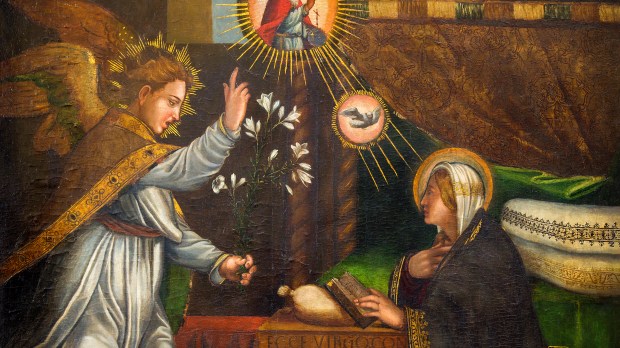The unique truth of Christianity is that God reveals himself as Love. This love, St. Thomas Aquinas teaches, is the energy force that binds together the three persons of the Holy Trinity. It is also, as Dante has written, “the force that moves the sun and all the other stars.”
The story of the Annunciation is probably the most familiar and famous account of an angelic encounter. The Virgin Mary is visited by Gabriel, the messenger from God, who invites her response to the news that she will bear God’s son. Her humble and simple “Let it be to me according to your word” echoes down through the ages as a response not of mindless submission, but of a simple love to the invitation by the greatest Love.
The encounter has moved countless artists and writers to meditate further on the angel of the annunciation and the meaning of the angel’s message. In “The Annunciation,” the Scottish poet Edwin Muir recounts a contemplative moment brought on by one of the commonplace sights for any visitor to Rome — a plaque on a wall depicting a saint or a scene from Scripture:
I remember stopping for a long time one day to look at a little plaque on the wall of a house in the Via degli Artisti [Rome], representing the Annunciation. An angel and a young girl, their bodies inclined toward each other, their knees bent as if they were overcome by love, “tutto tremante,” gazed upon each other like Dante’s pair; and that representation of a human love so intense that it could not reach farther seemed the perfect earthly symbol of the love that passes understanding.
This is the deepest meaning of Gabriel’s visit to the Blessed Virgin Mary: it is the visit of God, whose love is so great that it will bear fruit in the incarnation of that love in the world. The truth is given witness by the Evangelist John who says, “God so loved the world that he gave his only begotten Son, so that whoever believes in him will have eternal life.”
This message from God to our world is not simply the message of an angel, but a message incarnate in a human person. Jesus Christ is God’s message of love in the world. Other religions may claim that their holy book is the message of the angel Gabriel. Catholics know that the true message of Gabriel is not a book of rules and regulations, but a person. If the message is a person, not just a rulebook, then that person invites us into a relationship. In Mary’s Son God’s love incarnate reaches out to us and demands a response.
The reason why the scene of the annunciation is depicted so often in art and poetry is because art and poetry are the best ways to express the emotions that surround this extraordinary event. We may contemplate the event and analyze the event theologically, but in the end the annunciation must be entered into by pondering with awestruck minds and hearts the true depth and astounding meaning of what took place.
God entered this world not as a mighty warrior, vengeful judge or almighty creator but as an innocent child born of a young woman. Advent is therefore the time to meditate on this mystery and enter into this love not only with our minds but with our hearts.
Muir’s encounter in Rome with that ordinary artwork inspired a poem that takes us to the mysterious heart of history’s greatest angel encounter.
The angel and the girl are met. Earth was the only meeting place. For the embodied never yet Travelled beyond the shore of space. The eternal spirits in freedom go. See, they have come together, see, While the destroying minutes flow, Each reflects the other’s face Till heaven in hers and earth in his Shine steady there. He’s come to her From far beyond the farthest star, Feathered through time. Immediacy Of strangest strangeness is the bliss That from their limbs all movement takes. Yet the increasing rapture brings So great a wonder that it makes Each feather tremble on his wings. Outside the window footsteps fall Into the ordinary day And with the sun along the wall Pursue their unreturning way. Sound’s perpetual roundabout Rolls its numbered octaves out And hoarsely grinds its battered tune. But through the endless afternoon These neither speak nor movement make, But stare into their deepening trance As if their gaze would never break.

